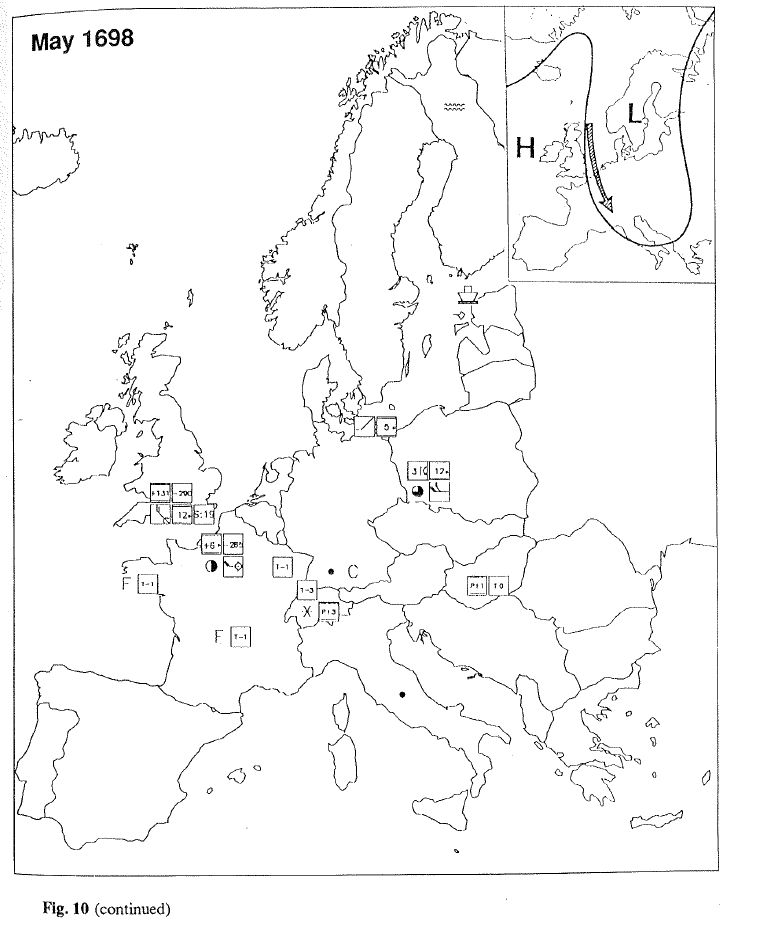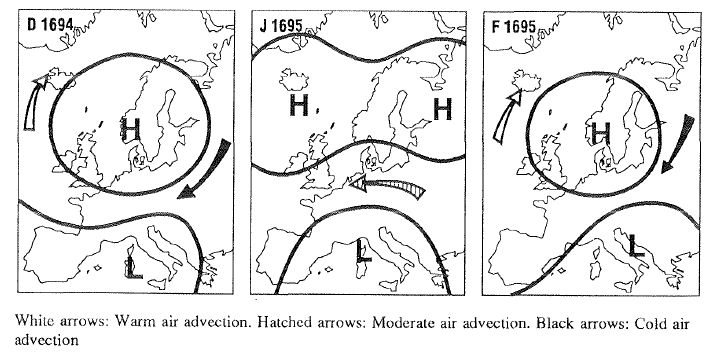Euro-Climhist – a Long History
The Euro-Climhist climate history database has grown continuously over a period of more than 40 years. Its beginnings date back to the 1970s, when it was based on punch cards. It received its first major impetus for an international focus on the whole of Europe in the early 1990s as part of a project and several conferences organised by the European Science Foundation. Due to a lack of funding, the project developed very slowly between 1995 and 2009. Finally, from 2010, the project was expanded and professionalised, including in the area of technical staff, which was made possible by substantial funding from the Global Climate Observing System (GCOS) Switzerland at the Federal Office of Meteorology and Climatology MeteoSwiss. As a result, general, web-based access to the database can now be provided; not only have new data sets been continuously incorporated, but fundamental technical updates have also been carried out.
Beginnings in the Period of Punched Cards (1977-1989)
The history of Euro-Climhist begins with a research grant from the Swiss National Science Foundation (1975-1977), which enabled Christian Pfister to lay the foundations for his later habilitation thesis on the history of climate in Switzerland. This work was inspired by Emmanuel Le Roy Ladurie's ground-breaking "Histoire du climat depuis l'an mil" (1967) and Hubert Horace Lamb's "Climate, Present, Past and Future" (1977). Le Roy Ladurie (1929-2023) was a historian with a flair for the history of climate, Lamb (1913-1997) a climatologist with a flair for human history. The "Klimageschichte der Schweiz", Pfister's habilitation thesis, was published in 1984 and is based on 34,000 pieces of data from numerous archives, from which temperature and precipitation indices were derived. A software package called SRTCLIM, based on the PL-1 programming language, had been developed for this purpose since the late 1970s, within the framework of which thousands of punched cards had to be created. From 1985, the CLIMHIST-CH documentation was sold to libraries and scientific institutions in the form of microfiches and paper printouts, as there were no other favourable publication channels in the "Ancien Régime of Information Technology". Only the paper version survived the numerous IT upheavals in the following years, which was decisive for the continuation of the project.
A Child of the "European Science Foundation" (1990-1994)
The cradle of Euro-Climhist is the "European Paleoclimate and Man since the Last Glaciation" project launched in 1989 by Burkart Frenzel of the "European Science Foundation" (ESF). It was designed to clarify the influence of humans on the climate. Lamb had asked about the influence of the climate on human history and, to this end, convened an international "Conference on Climate and History" in Norwich (England) in 1979. It brought together more than 250 representatives of history, geography, climatology and archaeology, who had previously worked more or less in isolation. Historical climate research found its place in the ESF project in the reconstruction of weather and climate on the basis of documentary data; Christian Pfister was entrusted with the management of the corresponding working group.
The ESF Conferences of Mainz (1990) and Bern (1992)
The first meeting within the framework of this project took place in Mainz in March 1990 in order to develop a joint research strategy (Frenzel, Pfister, Gläser 1992). Among those invited were later leading representatives of historical climatology, including Rudolf Brázdil from Masaryk University in Brno and Rüdiger Glaser, who now teaches in Freiburg/Breisgau. The participants decided to compile data for a specific time interval, the late Maunder Minimum (1675-1715), which is known for its frequent weather extremes. The project created the opportunity to invite young researchers from the partner countries to Bern, where they familiarised themselves with the method. Some of them, such as Petr Dobrovolný from the Czech Republic, Elena Xoplaki from Greece and Lajos Rácz from Hungary, went on to become leading (historical) climatologists in their countries.
A second ESF conference entitled "Climatic Trends and Anomalies in Europe 1675-1715" took place from 3 to 5 September 1992 at the University of Bern (Frenzel, Pfister, Gläser 1994). It brought together 51 representatives of (historical) geography, history, dendroclimatology, meteorology and climatology from 15 European nations as well as from China and Japan. This was the first international symposium for which the participants had to provide various types of historical climate data - early instrument measurements, narrative document data, climate data from tree-ring analyses and other proxy data - for a common database, which was output in the form of chronological, spatial and thematic lists and monthly historical weather maps.
In future, the material was to be integrated into a database called EURO-CLIMHIST, where it was to be standardised, processed and systematically converted into historical weather maps according to the model of Horace Hubert Lamb (Lamb 1997) and John Kington (Kington 1994) (Pfister et al. 1994; Wanner et al. 1994).
The First Euro-Climhist Database
The first Euro-Climhist database was created with the support of the Swiss National Science Foundation (SNSF) by Hannes Schüle, Gudrun Kleinlogel and Erich Siffert on the methodological basis of CLIMHIST-CH. The endeavour proved to be time-consuming because the codebook had to be greatly expanded to include new codes (e.g. for icebergs) and new data types (e.g. ship logs).
In the end, a set of 492 monthly historical weather maps was created for the conference in Bern.
The Synoptic Interpretation of Historical Weather Charts
The meteorological interpretation of these maps proved to be more challenging than expected.
In May 1993, a group of climatologists led by the Swiss Heinz Wanner met at the invitation of the Danish Meteorological Institute in Copenhagen. At the Bern conference, Wanner had been inspired by the method of synoptic, i.e. comparative interpretation of historical weather maps. Over the course of a week, the team succeeded in interpreting 200 such historical weather maps synoptically (Wanner et al. 1994).
Prof Dr Heinz Wanner, later Professor of Climatology in Bern, was to become one of the leading researchers in this field. His student Jürg Luterbacher, who later held a professorship in climatology in Giessen and has been Director of the Science and Innovation Department of the World Meteorological Organisation (WHO) in Geneva since 2020, developed a globally recognised statistical method for the spatial reconstruction of temperature, air pressure and precipitation on the basis of data from natural and social archives (e.g. Luterbacher et al. 2002).

Spatial representation of weather information from document data, May 1698. This May was one of the coldest in the last 500 years. Source: Pfister et al. 1994: 363.

Major European weather patterns for December 1694, January 1695 and February 1695. source: Wanner et al. 1994: 416.
In the Long Slumber (1995-2009)
From the mid-1990s, there was less demand for documentary data on climate reconstruction. The ESF project came to an end and the vigour of the early 1990s petered out. Euro-Climhist was only continued on a low flame with residual loans and modest own funds, in particular for the integration of medieval and early modern data collected by Werner and Gabriela Schwarz-Zanetti as part of their dissertations. Nevertheless, the research network that had been set up as part of the ESF project remained largely intact. These efforts were continued in 1999 with the compilation of a special volume on the European climate in the (late) 16th century and its significance for economic and cultural history (Pfister, Brázdil, Glaser 1999). After 2000, Urs Dietrich-Felber (2008) and Max Burri developed Euro-Climhist into a database based on Microsoft Access, but this soon proved to be no longer viable for the future.
A Fresh Start in the Age of the Internet (Since 2010)
In June 2009, the Federal Council included Euro-Climhist in the list of Swiss data platforms of international importance to be maintained in the long term. This decision allowed Euro-Climhist to be redesigned and expanded into a public, internet-based information system in the longer term. Following the retirement of Christian Pfister, his successor at the Chair of Environmental and Climate History, Christian Rohr, took over the management of Euro-Climhist. The project was now not only supported by the Oeschger Centre of the University of Bern and the Department of Economic, Social and Environmental History (WSU) of the Historical Institute of the University of Bern, but since 1 July 2010 also by the Global Climate Observing System (GCOS) Switzerland at the Federal Office of Meteorology and Climatology MeteoSwiss. This required the development of a new, systematic categorisation system. The previous 2400 or so codes for weather phenomena were summarised to just under 300 codes, but without any loss of detail thanks to the inclusion of complementary codes that can be expanded without restriction. Several tens of thousands of new data were also added. Release 1 of Euro-Climhist was launched on 3 May 2012, but it soon had to be taken offline due to teething problems. On the IT side, the project then suffered from vacancies in the technical area for more than two years. From December 2014, Antoine Jover, as Database Manager, was able to prepare the project for going public in 2015 within a few months in close collaboration with Matthias Fries. In 2022-2023, Matthias Fries and Lukas Würsch carried out an extensive relaunch to make the operating system fit for the coming years.
What next?
Euro-Climhist has been expanded for several years at European level through co-operation projects in which research groups publish their data using the methodology and software developed for Euro-Climhist. The corresponding data remain the property of the respective authors. Each dataset is labelled with the abbreviation of the corresponding contributor. Those responsible for Euro-Climhist provide assistance with the recording, processing and integration of the data. In this way, the standardisation of the data field necessary for supra-regional research can be achieved and at the same time the independent authorship of regional groups can be guaranteed. A separate tool with an input mask was developed for data entry in 2023, which is intended to facilitate and accelerate both the input and evaluation process in the long term. Co-financing by GCOS Switzerland is initially secured until the end of 2027.
